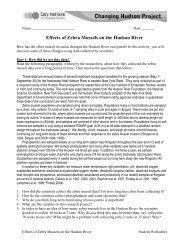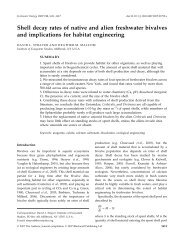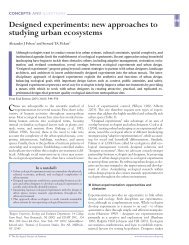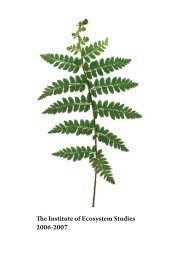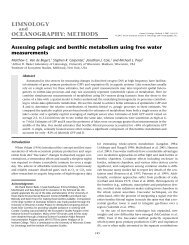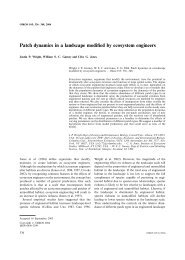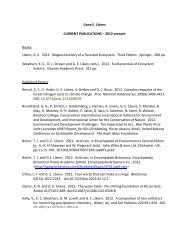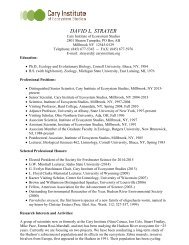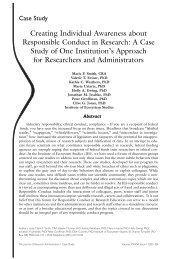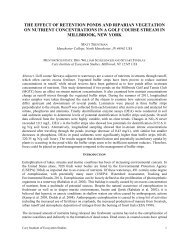Patterns and regulation of dissolved organic carbon
Patterns and regulation of dissolved organic carbon
Patterns and regulation of dissolved organic carbon
Create successful ePaper yourself
Turn your PDF publications into a flip-book with our unique Google optimized e-Paper software.
1216 Sobek et al.<br />
concentration has been reported to be negatively related to<br />
lake area (Rasmussen et al. 1989; Xenopoulos et al. 2003),<br />
but no such relationship has been found in other regions<br />
(Houle et al. 1995). In Finnish lakes, lake area was not<br />
a good predictor <strong>of</strong> TOC concentration, but nevertheless,<br />
median TOC concentration in small lakes was higher than<br />
in large lakes (Kortelainen 1993). When dividing our data<br />
set into 73 subsets <strong>of</strong> geographically well-confined regions<br />
(containing at least 15 lakes), we found negative relationships<br />
between lake area <strong>and</strong> DOC for several, but not all<br />
regions (data not shown). Thus, there was no consistent<br />
effect <strong>of</strong> lake area on the DOC concentration <strong>of</strong> lakes.<br />
Furthermore, we could not observe an effect <strong>of</strong> drainage<br />
ratio (catchment : lake area) on lake DOC (Fig. 4), again in<br />
accordance with the study <strong>of</strong> lakes in different regions by<br />
Xenopoulos et al. (2003). In regional studies, drainage ratio<br />
has sometimes been found to be important (Engstrom 1987;<br />
Rasmussen et al. 1989; Kortelainen 1993), but sometimes not<br />
(Houle et al. 1995). When dividing our data into regional<br />
subsets, we found positive relationships between drainage<br />
ratio <strong>and</strong> DOC for a few, but far from all regions (data not<br />
shown). Drainage ratio influences lake DOC concentration<br />
in two different ways, both <strong>of</strong> which are in the same direction.<br />
First, the DOC loading rate increases with increasing<br />
drainage ratio, <strong>and</strong> second, high drainage ratio implies high<br />
flushing rates <strong>of</strong> lakes <strong>and</strong> thus low in-lake loss <strong>and</strong> high<br />
concentration <strong>of</strong> DOC. However, both effects are dependent<br />
on water flows <strong>and</strong> thus climate, which implies that drainage<br />
ratio will necessarily be a better predictor <strong>of</strong> lake DOC within<br />
a climatically homogeneous region than across climatic<br />
zones. Further, Engstrom (1987) demonstrated that only<br />
drainage ratios ,6–10 will affect lake DOC, which implies<br />
that in regions with different topographies, the drainage ratio<br />
will be differently important for lake DOC. In our data set,<br />
81% <strong>and</strong> 64% <strong>of</strong> the lakes had drainage ratios above 6 <strong>and</strong><br />
10, respectively, which, according to Engstrom (1987), would<br />
suggest that the DOC concentration in many lakes in our<br />
data set is not dependent on drainage ratio.<br />
The observation that drainage ratio <strong>and</strong> lake area can be<br />
important predictors <strong>of</strong> lake DOC in many regions, but not<br />
in lakes distributed across different geographical regions,<br />
suggests that other environmental conditions set an average<br />
regional DOC level, <strong>and</strong> that drainage ratio <strong>and</strong> lake area<br />
determine a certain part <strong>of</strong> the variation around that<br />
average regional DOC level in individual lakes. We tested<br />
this hypothesis by first using the multiple linear regression<br />
model (Fig. 5F; Eq. 2) to predict the log DOC concentration<br />
from altitude, run<strong>of</strong>f, <strong>and</strong> soil <strong>carbon</strong> for all lakes.<br />
Next, we plotted the residual variation in globally predicted<br />
log DOC against log lake area <strong>and</strong> log drainage ratio for<br />
the 73 regional subsets <strong>of</strong> lakes. There were significant<br />
linear relationships (p , 0.05) between the residuals <strong>of</strong><br />
globally predicted log DOC <strong>and</strong> log lake area in 42% <strong>of</strong> the<br />
regional subsets (data not shown), explaining on average<br />
17% <strong>of</strong> the residual variance in log DOC (range 3–35%).<br />
The slopes <strong>and</strong> intercepts <strong>of</strong> these relationships varied<br />
greatly (ranges 20.82 to 0.11 <strong>and</strong> 20.87 to 0.27, respectively),<br />
<strong>and</strong> they illustrate the great difference in the<br />
importance <strong>of</strong> lake area for lake DOC between regions.<br />
Likewise, there were significant linear relationships (p ,<br />
0.05) between the residuals <strong>of</strong> globally predicted log DOC<br />
<strong>and</strong> log drainage ratio in 26% <strong>of</strong> the regional subsets (data<br />
not shown), explaining on average 15% <strong>of</strong> the residual<br />
variance in log DOC (range 1–40%). Also, for the drainage<br />
ratio, the regression statistics were highly variable (ranges<br />
for the slope <strong>and</strong> intercept were 20.33 to 0.54 <strong>and</strong> 20.93 to<br />
0.22, respectively). Nevertheless, the fact that lake area <strong>and</strong><br />
drainage ratio explained significant proportions <strong>of</strong> the<br />
residual variance in lake DOC within many geographically<br />
confined regions illustrates the hierarchical <strong>regulation</strong> <strong>of</strong><br />
lake DOC. The climate, topography, <strong>and</strong> hydrology set the<br />
potential range <strong>of</strong> lake DOC concentrations within each<br />
region, <strong>and</strong> catchment <strong>and</strong> lake characteristics (drainage<br />
ratio, % wetl<strong>and</strong>s, % upstream lakes, water retention time)<br />
regulate the DOC concentration <strong>of</strong> each individual lake.<br />
This implies that regional empirical models on DOC<br />
concentration in lakes are limited in their applicability to<br />
global extrapolations (Xenopoulos et al. 2003) as well as to<br />
other regions, even if situated within relatively short<br />
distances (Rantakari et al. 2004).<br />
Sources <strong>of</strong> additional variability in lake DOC—Regional<br />
models <strong>of</strong> <strong>organic</strong> <strong>carbon</strong> in lake water rendered degrees <strong>of</strong><br />
explanation in the range <strong>of</strong> 31–75% (most frequently 50–<br />
70%), <strong>and</strong> an analysis including lakes from several different<br />
regions explained 45% <strong>of</strong> the variability in lake DOC<br />
(Rasmussen et al. 1989; Xenopoulos et al. 2003; Rantakari<br />
et al. 2004). Hence, our models compare well to earlier<br />
studies. The fact that our analyses leave 52% <strong>of</strong> the<br />
variability in lake DOC unexplained can be attributed to<br />
a multitude <strong>of</strong> factors. First, several important features <strong>of</strong><br />
the lakes <strong>and</strong> their catchments were not part <strong>of</strong> our data<br />
set. If we had been able to assemble data on, for example,<br />
the proportion <strong>of</strong> wetl<strong>and</strong>s <strong>and</strong> upstream lakes <strong>and</strong> on the<br />
volume or flushing rate <strong>of</strong> the lakes, we probably would<br />
have been able to explain a greater share <strong>of</strong> the variability<br />
in lake DOC. Second, the grid size <strong>of</strong> some <strong>of</strong> the databases<br />
was probably considerably larger than the actual local<br />
variability, especially in mountain areas, which adds<br />
additional variation to the analyses. Third, most DOC<br />
concentrations are derived from one single measurement,<br />
which leaves a considerable amount <strong>of</strong> temporal variability<br />
in the data. Fourth, the conversion <strong>of</strong> TOC to DOC by<br />
means <strong>of</strong> a conversion factor may introduce additional<br />
variability in a part <strong>of</strong> the data set. Last, differences in<br />
sampling <strong>and</strong> analytical protocols among the many studies<br />
<strong>and</strong> surveys will also add to the total unexplained variance.<br />
Linkages among climate, catchments, <strong>and</strong> lakes—This<br />
paper shows for the first time that the climatic <strong>regulation</strong> <strong>of</strong><br />
DOC concentration in lakes, which has been observed<br />
using time series data (Pace <strong>and</strong> Cole 2002), can also be<br />
observed over a wide spatial gradient. Combined with the<br />
global-scale importance <strong>of</strong> the proportion <strong>of</strong> wetl<strong>and</strong>s in<br />
the catchment on lake DOC (Xenopoulos et al. 2003), our<br />
study exemplifies the hierarchical structure <strong>of</strong> the <strong>regulation</strong><br />
<strong>of</strong> DOC in lakes: climate <strong>and</strong> topography regulate<br />
terrestrial vegetation, soils, <strong>and</strong> hydrology, which in turn<br />
set the range <strong>of</strong> possible DOC concentrations in lakes <strong>of</strong><br />
one region. Then, the DOC concentration <strong>of</strong> each in-



